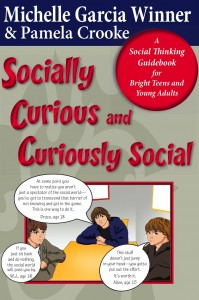What do you say to your 14-year-old socially challenged son when he comes home from high school and says to you, “Mom, how do I make small talk? My teacher says the topics I talk about can’t be sustained in a conversation. How do the other kids just get together at lunch and after school? My problem is that I don’t know how to organize getting together with other kids.” You might have responded as I did—with initial heartbreak at your son’s difficulties in establishing friendships that he deeply desires. Then you might have thought, how does someone make small talk if it doesn’t come naturally, or how do I explain to my son how group dynamics really work? You might have felt as I did that you wanted to be able to explain to your child how to communicate more effectively or join a group without knowing how to describe what most of us learn “naturally” without much thought or reflection.
If you have a teen or young adult who is struggling socially as my teen is, Socially Curious and Curiously Social will seem like a godsend to you. From their years of clinical experience, the authors, Michelle Garcia Winner and Pamela Crooke, have a profound understanding of what makes people with social cognitive deficits tick. They are able to explain the seemingly unexplainable nuances of communication in analytical terms that a bright but socially impaired teen or young adult can understand and really “get.” Abstract social and communication concepts are broken down into components, with the what, why, and how of each step in communication stated explicitly. Readers are continually motivated not only to learn more about communication, but also to put what they are learning into practice. At every step of the way, they are encouraged to do what doesn’t come easily for them in order to obtain the rewards that await them.
While Socially Curious and Curiously Social is written for the socially challenged teen or young adult, I would highly recommend it to parents Socially Curious and Curiously Social and teachers as well. As a result of reading the book, I can now provide intelligent answers to those difficult questions my son asks about communication and social dynamics. More importantly, I now have a framework to help my child learn and practice the components of communication. I am eager to buy a copy of the book for my son’s special education teachers so that as a team, we can identify and teach my son those components of communication (at school as well as at home) most in need of improvement. By breaking my son’s longstanding (and still unmet!) IEP goal of “communicating more effectively with peers” into smaller, more manageable components, I am hopeful that greater progress can be made.
I thank the authors for their commitment to individuals like my son who have so much to offer and yet face social challenges daily. I am truly excited about this book and cannot wait to share it with others!
—Paula, Mom of individual with Aspergers
Paula and parents like her struggle on a daily basis to explain the complex and nuanced social world to teens and young adults with social thinking challenges. For those of us who “get” this information pretty much through osmosis, trying to teach it can be frustrating. And our students at this age really do want to do this learning by themselves—or with their peers—as much as is possible. It’s a time of independence and exploration, wanting to bond with others their same age. The parental or educator’s urge to step in and “teach” (or do-for) runs deep, yet at some point we have to balance that urge with respect for their blossoming independence and let them venture out themselves. When it comes to social thinking and acting, that can be a disaster waiting to happen!
After thirteen years of working with teens and young adults to help them be more successful socially, we found many wanting information delivered to them in a way they could access themselves. And, that’s exactly why Socially Curious and Curiously Social came about—to provide our students with a guidebook to learn about themselves, explore the basic social concepts from which our social behaviors spill forth, and understand how to adapt in different social situations by modifying how they think about others and themselves.
Remarkably, as adult teachers and parents we are generally uncomfortable talking about emotions and the impact of our social behaviors.
It’s just not something we’re trained or experienced in doing. Plus, we bring to this task all our individual preconceptions and our own social “baggage.” Few tools exist to explain the thoughts we have about people, our hidden social expectations, how social behavior affects our own emotions and how our emotional states, in turn, affect how we treat others.
Although this book is written for the teen or young adult, parents and educators will also gain a better understanding of ways to discuss and explain core social thinking concepts by reading this book.
The content in this book has had “in-the-trenches” testing with teens and young adults with whom we’ve worked. Many edits and revisions arose from their honest and no-frills-attached reviews. The book is appropri- ate for just about anyone who is adolescent or older. It is a practical and useful basis for, or companion to, a social learning curriculum in school or as an after-school program. Students can read age-appropriate information while also being encouraged to observe others and write related journal entries and essays about their own social thinking and what they see in others.
Many of the core concepts related to teaching social thinking and related social skills have been described in a number of other books written for parents, caregivers and educators. Two books, in particular, expand on the social thinking concepts discussed in this book: Thinking About You, Thinking About Me, 2nd edition (Winner, 2007) and Think Social: A
Social Thinking Curriculum for School Age Students (Winner, 2005). These books can be found at www.socialthinking.com, along with free helpful information about social thinking and related academic challenges.
There’s lots of material at your fingertips for those times when you get “stuck” in explaining different social concepts. Students in K-5th grade, those just starting to learn the most basic social thinking concepts, may enjoy the book, You Are A Social Detective. It is also a prerequisite and companion to our Superflex Social Thinking Super Hero Curriculum for kids in this same age group. We hope as you read, review and assimilate these social thinking concepts you’ll find, as we have, that this information is beneficial for all of Socially Curious and Curiously Social us to understand and practice. We all “mess up” social interactions on a fairly routine basis. It’s common ground all of us share, whether or not we have a disability label attached to us. In gaining knowledge about social thinking and related social skills, we can each navigate more successfully through the thoughts and minds of others. It’s an exciting journey, one that never stops. In the end, that’s precisely what makes it so fascinating!
—Michelle Garcia Winner and Pamela Crooke
 For the Teen/Young Adult Reader: This Book’s For You!
For the Teen/Young Adult Reader: This Book’s For You!
If you’re reading this book to find out about social thinking for yourself, good for you! Maybe you’re curious about the social world, or maybe you’ve been told you “just don’t get it.” No worries. You’re taking the first step in learning about the sometimes tricky, sometimes confusing, but awesome world of social relationships. We’ve worked with many teens and young adults who have had the same questions and challenges as you might be having now. They’ve taught us how important it is to break the social world down into smaller parts to help them understand what seems to be hidden, while still finding successes along the way. The stories in this book are true stories about real people who’ve struggled with some of the same issues that you find just plain hard!
We truly believe every one of us has different kinds of intelligences. Some of us are amazing at math, others at science, art or computers. Some of us are athletes or historians. Most of us are good learners in some areas and not so great in other areas. That’s just the way it is. If you’re reading this book you’re probably pretty good at school or science or [fill in the blank] type of thinking, but are hoping to make the social part of your brain and thinking expand. It’s a journey worth taking!
So your mission (if you choose to accept it) is to dive into this book to solve some of those social curiosities and, in the meantime, make that brain of yours figure out the social world. You can do it! Others have gone before you and have lived to tell the tale. In the Introduction that follows, you’ll see some of their thoughts about social thinking, in their own words.







